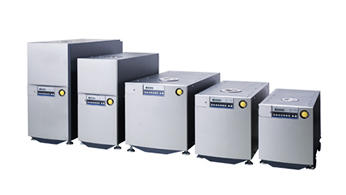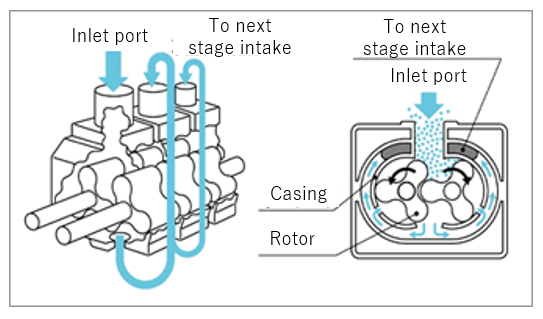Fundamentals of Vacuum Pumps (High Vacuum)
Multi-Stage Roots Vacuum Pump
What is an oilless vacuum pump?
An oilless vacuum pump is also called a dry vacuum pump.
A dry pump is a mechanical vacuum pump that does not require oil or liquid in a vacuum chamber. In the Flat Panel Display, electronics, and semiconductor industries, dry pumps are needed to improve production yield and maintainability. Roots dry vacuum pump is a typical example of such a pump.

Roots Vacuum Pump Applications:
- FPD manufacturing equipment
- Semiconductor manufacturing equipment
- Vacuum distillation
- Purification Degassing
- Sterilization
- Drying
- Dehydration
- Disinfection
Feature of MULTI-STAGE Roots Dry Pump
A multi-stage roots vacuum with a three-leaf-shaped rotor can compress and exhaust to atmospheric pressure by connecting a multi-stage rotor to a single shaft. This type of pump obtain a clean vacuum and enable to reach up to ultimate pressure.
How Multi-Stage Roots Dry Pump Works?
This pump has two three-leaf-shaped rotors (rotating body) in a box called casing. A pair of gears rotate in opposite directions at the same cycle. Rotors contact each other, and the rotor and casing do not contact each other. They rotate to transfer and compress gas while maintaining a small gap. The rotor has a multi-stage structure, compresses to atmospheric pressure, and then pumps it into the atmosphere. The gears and bearings use lubricating oil, but the seal structure is designed to prevent oil from entering the casing. Oil or other sealing fluid is not used in the rotor casing, which enables clean exhaust.

Fundamentals of Vacuum Pumps (High Vacuum)
- Screw Pump
- Multi-Stage Roots Vacuum Pump
- Dry Scroll Vacuum Pump
- Dry Diaphragm Vacuum Pump
- Dry Rocking Piston Vacuum Pump
- Dry Rotary Vane Vacuum Pump
- Oil Rotary Vacuum Pump
- Mechanical Booster Pump
- Cryopumps
- Turbomolecular Pump
- Ion Pump
- Titanium Sublimation Pump
- Sorption Pump
- Diffusion Pump
- Ejector Pump
HOW TO
- Vacuum Tech Basics
- Fundamentals of Vacuum Pumps (Low to Medium Vacuum)
- Fundamentals of Vacuum Pumps (High Vacuum)
- Fundamentals of Vacuum Valves
- Fundamentals of Vacuum Gauges
- Fundamentals of Quartz Crystal Oscillation Type Deposition Controller
- Fundamentals of Leak Detection
- Fundamentals of High-Speed Spectroscopic Ellipsometer
- Fundamentals of Gas Analyzer (Process Gas Monitor)
- The Others
- How to Choose The Best Products
- Old Models vs. New Models
- Troubleshooting